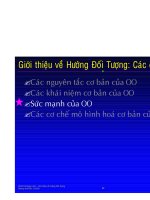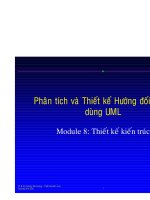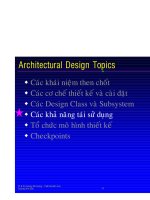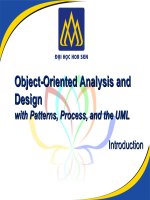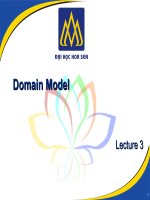Phân tích thiết kế hướng đối tượng (phân 2) doc
Bạn đang xem bản rút gọn của tài liệu. Xem và tải ngay bản đầy đủ của tài liệu tại đây (1.08 MB, 50 trang )
1 Case study: automatic teller machine
32
Answer 1.14
Answer 1.14Answer 1.14
Answer 1.14
There are several possible strategies: proceed with grouping by actor, by functional
domain, etc. In our example, grouping use cases by primary actor is natural, as this
also allows the secondary actors to be distributed.
The inclusion use case, Authenticate, is placed in a separate package as a shared
support service, in order to distinguish it from the real functional cases which
include it. The dependency arrows between packages synthesise the relationship
between the contained use cases. The following diagram presents the proposed
structuring of the use cases by making the primary actor appear in front of each
package to remind us which actor is connected to which package.
18
Note that the
use of double-headed filled arrows to connect packages to their primary actors is
not UML syntax, but here only to explain the packaging.
18. UML 2.0 has just added the concept of “package diagram”: A diagram that depicts how model
elements are organised into packages and the dependencies among them, including package
imports and package extensions. Figure 1.17 belongs to this kind of organisational diagram.
Figure 1.17 Structuring of the ATM use cases
Visa
CardHolder
Bank
customer
Maintenance
operator
Visa withdrawl
Customer transactions
Maintenance
Dependency between
packages
Support services
Packages
07_Chapter_01_Roques_NEW.fm Page 32 Friday, November 28, 2003 1:21 PM
1.6 Step 6 – Organising the use cases
33
We can now create a use case diagram for each of the three main packages.
Figure 1.18 Use case diagram of the Visa withdrawal package
Figure 1.19 Use case diagram of the Customer transactions package
Visa
CardHolder
Withdraw money using
a Visa card
secondary
<<Actor>>
Visa AS
<<include>>
Authenticate
(Support services)
Bank
customer
Withdraw money using
a bank card
(Verify available amount)
<<extend>>
Consult balance
secondary
secondary
secondary
<<Actor>>
Bank IS
Deposit cashDeposit cheques
Deposit money
<<include>>
<<include>>
<<include>>
Authenticate
(Support services)
07_Chapter_01_Roques_NEW.fm Page 33 Friday, November 28, 2003 1:21 PM
1 Case study: automatic teller machine
34
Note that Figure 1.19 is still complex, mainly because we chose to show graphically
the relationship between use cases. You must be aware that these UML constructs
are potentially dangerous in that the more complex syntax makes the diagram less
intuitively obvious to read. They can also lead to modelling errors, that is why
many practitioners tend to discourage using them. For instance, Rosenberg
19
points out in his “Top 10 Use Case Modelling Errors”: Spend a month deciding
whether to use include or extend! And Cockburn
20
explicitly warns: “if you spend
much time studying and worrying about the graphics and the relations, you are
expending energy in the wrong place. Put it instead into writing easy-to-read
prose.”
Bibliography
BibliographyBibliography
Bibliography
19. Applying Use Case Driven Object Modeling with UML: An Annotated e-Commerce Example,
D. Rosenberg, K. Scott, Addison-Wesley, 2001.
20. Writing Effective Use Cases, A. Cockburn, Addison-Wesley, 2001.
Figure 1.20 Use case diagram of the Maintenance package
[Adolph 02] Patterns for Effective Use Cases, S. Adolph, P. Bramble, Addison-
Wesley, 2002.
[Bittner 02] Use Case Modeling, K. Bittner, I. Spence, Addison-Wesley, 2002
[Booch 99] The Unified Modeling Language User Guide, G. Booch, Addison-
Wesley, 1999.
Maintenance
operator
Refill dispenser
Retrieve cards that have been swallowed
Retrieve cards that have been deposited
07_Chapter_01_Roques_NEW.fm Page 34 Friday, November 28, 2003 1:21 PM
1.6 Step 6 – Organising the use cases
35
[Cockburn 01] Writing Effective Use Cases, A. Cockburn, Addison-Wesley, 2001.
[Fowler 03] UML Distilled (3rd Edition), M. Fowler, K. Scott, Addison Wesley,
2003.
[Jacobson 99] The Unified Software Development Process, I. Jacobson et al., Addison
Wesley, 1999.
[Kulak 03] Use Cases: Requirements in Context (2nd Edition), D. Kulak, E.
Guiney, Addison-Wesley, 2003.
[Larman 01] Applying UML and Patterns, (2nd Edition): An Introduction to Object-
Oriented Analysis and Design, C. Larman, Prentice Hall, 2001.
[Rosenberg 99] Use Case Driven Object Modeling with UML, D. Rosenberg, Addison-
Wesley, 1999.
[Rosenberg 01] Applying Use Case Driven Object Modeling with UML: An Annotated
e-Commerce Example, D. Rosenberg, K. Scott, Addison-Wesley, 2001.
[Rumbaugh 99] The Unified Modeling Language Reference Manual, J. Rumbaugh,
Addison-Wesley, 1999.
[Schneider 01] Applying Use Cases: A Practical Guide (2nd Edition), G. Schneider,
J. Winters, Addison-Wesley, 2001.
07_Chapter_01_Roques_NEW.fm Page 35 Friday, November 28, 2003 1:21 PM
07_Chapter_01_Roques_NEW.fm Page 36 Friday, November 28, 2003 1:21 PM
2
21
Case study 2A – Problem statement
This exercise concerns a simplified system of a supermarket cash register. It is
inspired to a great extent by the case study of C. Larman’s first book (the Point-of-
Sale System), which formed the basis of the Valtech training about OOAD.
22
Aims of the chapter
In this chapter, two new case studies will allow us to complete our study of the main
difficulties, which concern the implementation of the use case technique.
For the first case study, we will elaborate a complex use case diagram (with
relationship between use cases), and add an advanced notation: navigability on
associations between actors and use cases. Then we will introduce the difference
between essential use case and real use case, a concept that was initially put forward
by C. Larman,
21
and see how it influences the textual description of use cases. An
example of a state diagram showing the forced sequence of system operations
(another interesting concept from Larman) will follow.
The second case study gives an example of how to use the UML concepts of
actors and use cases to model the business of a company, and not only an
information system. We will introduce business modelling stereotypes such as
business worker and business actor and see how to utilise them in use case
diagrams. Then we will illustrate the important activity diagram, proposed by UML
to describe business processes. To end this case study we will see how business
modelling can help to find actors and use cases for a future software system.
21. Refer to Applying UML and Patterns (2nd Edition), Prentice-Hall, 2001.
22. Object Oriented Analysis and Design.
Complementary
exercises
2
08_Chapter_02_Roques_NEW.fm Page 37 Friday, November 28, 2003 1:21 PM
2 Complementary exercises
38
The standard procedure of using a cash register is as follows:
• A customer arrives at the checkout to pay for various items
• The cashier records the bar code number of each item, as well as the quantity if
it is greater than one.
• The cash register displays the price of each item and its description.
• When all the purchases are recorded, the cashier indicates the end of the sale.
• The cash register displays the total cost of the purchases.
• The customer selects his or her payment method:
• Cash: the cashier takes the money from the customer and puts it in the cash
register, the cash register indicates how much change the customer is to be
given;
• Cheque: the cashier verifies that the customer is financially solvent by
sending a request to an authorisation centre via the cash register;
• Credit card: a banking terminal forms part of the cash register. It sends a
request for authorisation to an authorisation centre, according to the card
type.
• The cash register records the sale and prints a receipt.
• The cashier gives the receipt to the customer.
08_Chapter_02_Roques_NEW.fm Page 38 Friday, November 28, 2003 1:21 PM
Case study 2A – Problem statement
39
Once the items have been entered, the customer can present money-off vouchers
for certain items to the cashier. When the payment transaction is finished, the cash
register sends the information on the number of items sold to the stock
management system.
Every morning, the shop manager initialises the cash registers for the day.
*** 2.1 Construct a detailed use case diagram of the cash register.
Do not hesitate to use relationships between use cases in order to make your
diagram more precise.
Answer 2.1
Answer 2.1Answer 2.1
Answer 2.1
First, a simplistic solution entails identifying a “big” use case, which contains the
entire standard procedure involved in using the cash register, and another use case
that deals with initialisation of the cash register by the shop manager.
If we add the secondary actors to the previous diagram, we notice that the Process
sale use case communicates with a large number of different actors.
Figure 2.1 First draft of the use case diagram
Cashier
Shop manager
Process sale
Initialise cash register
Case study 2A
08_Chapter_02_Roques_NEW.fm Page 39 Friday, November 28, 2003 1:21 PM
2 Complementary exercises
40
Receive-only actor
Receive-only actorReceive-only actor
Receive-only actor
Note the use of the navigation arrow on the association with the non-human Stock
management actor, which makes it clear that the actor can only receive messages
from the system without actually sending it any in return.
This increase in the number of secondary actors leads us to deduce that this use case
has too many responsibilities, and that it would therefore be sensible to divide it
up into more atomic sections.
We might think that all we have to do is divide it up sequentially, as illustrated
on the following figure.
Figure 2.2 Second draft of the use case diagram
Cashier
Process sale
secondary
secondary
secondary
secondary
Customer
<<actor>>
Authorisation centre
for cheques
<<actor>>
Stock management
<<actor>>
Authorisation centre
for cards
Shop
manager
Initialise cash register
Navigability
08_Chapter_02_Roques_NEW.fm Page 40 Friday, November 28, 2003 1:21 PM
Case study 2A – Problem statement
41
Though tempting, this solution is rarely recommended. This is because the use
cases that result from it no longer truly conform to the UML definition. For
example, can we consider that End sale may represent a service that is offered by the
system from start to finish?
Rather, the level of detail that is thus obtained is similar to what Larman calls
system operations, or a unit of processing that is realised by the system within the
framework of a use case, and which can possibly be reused within another.
Recording the items and closing the sale both involve the same actors and
inevitably follow one another at some point in time: there is therefore no reason to
separate them. On the other hand, the important variable part, which is linked to
the payment method that the customer chooses, leads to separation of the generic
payment procedure – thanks to an include relationship, – from the process of
dealing with cash register transactions. In this way, this enables specialised use
cases to be described, with each one making specific actors appear. The first part of
the problem statement can therefore be modelled as represented on the following
figure.
Figure 2.3 Sequential division of the main use case
Cashier
Record articles
secondary
secondary
secondary
secondary
secondary
secondary
Customer
End sale
Process payment
<<actor>>
Authorisation centre for cheques
<<actor>>
Stock management
<<actor>>
Authorisation centre for cards
Case study 2A
08_Chapter_02_Roques_NEW.fm Page 41 Friday, November 28, 2003 1:21 PM
2 Complementary exercises
42
The inclusion use case, Process payment, is entered in italics on the diagram to
indicate that it is an abstract use case (non-instantiable). To avoid overloading the
diagram, we have left out the associations with Cashier assistant and Customer on
Process payment. However, we will note that two specialised use cases possess a
specific association with an additional actor: the authorisation centre concerning
them.
We can now complete the model by integrating the end of the exposition.
The optional consideration of discount coupons is conveyed quite naturally by
an extend relationship with the main use case. The link with the external stock
management system gives rise to a unidirectional association with a new actor.
Initialisation of the cash register does not pose any difficulty. The completed use
case diagram is shown below.
Figure 2.4 Partial use case diagram
Cashier
Process sale
secondary
Customer
<<include>>
Abstract
use case
Process payment
Process cash payment
Process credit card payment
Process cheque payment
<<actor>>
Authorisation centre for cheques
<<actor>>
Authorisation centre for cards
08_Chapter_02_Roques_NEW.fm Page 42 Friday, November 28, 2003 1:21 PM
Case study 2A – Problem statement
43
Figure 2.5 Completed use case diagram
Shop
manager
Initialise cash register
Cashier
Extension point:
vouchers
Process sale
Extension
point
<<extend>>
(vouchers)
Account for money-off
vouchers
<<include>>
secondary
Customer
Process payment
<<actor>>
Stock management
Process cash payment
Process cheque payment
Process credit card
payment
<<actor>>
Authorisation centre for cheques
<<actor>>
Authorisation centre for cards
Case study 2A
08_Chapter_02_Roques_NEW.fm Page 43 Friday, November 28, 2003 1:21 PM
2 Complementary exercises
44
Essential/real use case
Essential/real use caseEssential/real use case
Essential/real use case
In his previously mentioned book, C. Larman introduced the distinction between
essential use case and real use case:
We will illustrate this difference with the following two questions.
** 2.2 Write an essential detailed description of the main use case: Process sale.
Answer 2.2
Answer 2.2Answer 2.2
Answer 2.2
Identification summary
Title: Process sale Type: detailed essential
Summary: a customer arrives at the checkout with the items he or she would like to
purchase. The cashier records the items and collects payment. At the end of the
transaction, the customer leaves with the items.
Actors: Cashier (primary), Customer (secondary).
Creation date: 05/17/02 Date of update: 11/10/02
Version: 1.1 Person in charge: Pascal Roques
Describes a process from the design
view
Explains a solution in terms of user
interface enviroment, data input, etc.
ESSENTIAL REAL
Describes a process from an
analysis view
Explains a process (relatively)
independently from the hardware/
software environment
08_Chapter_02_Roques_NEW.fm Page 44 Friday, November 28, 2003 1:21 PM
Case study 2A – Problem statement
45
Flow of events
Preconditions:
• The cash register is open; a checkout assistant is signed on to it.
Main success scenario:
1. This use case starts when a customer
arrives at the checkout with items that
he or she would like to purchase.
2. The cashier records each item. If there
is more than one of the same item, the
cashier also indicates the quantity.
3. The cash register establishes the price
of the item and adds the information
on the item to the sale in progress.
The cash register displays the
description and the price of the item
in question.
4. Once the cashier has recorded all the
items, he or she indicates that the sale
is finished.
5. The cash register calculates and
displays the total amount of the sale.
6. The cashier informs the customer of
the total amount.
7. The customer chooses a payment
method:
a. In the case of cash payment,
execute the “Process cash payment”
use case;
b. In the case of credit card payment,
execute the “Process credit card
payment” use case;
c. In the case of cheque payment,
execute the “Process cheque
payment” use case.
8. The cash register records the sale that
has been carried out and prints a
receipt.
9. The cashier gives the cash register
receipt to the customer.
10. The customer leaves with the items he
or she has purchased.
Case study 2A
08_Chapter_02_Roques_NEW.fm Page 45 Friday, November 28, 2003 1:21 PM
2 Complementary exercises
46
“Alternative” sequences:
A1: unknown bar code number
The A1 sequence starts at point 2 of the main success scenario.
3. The cash register informs the cashier that the bar code number is unknown. The
item can therefore not be included in the sale in progress.
The scenario goes back to point 2.
Error sequences:
E1: customer is unable to pay
The E1 sequence starts at point 6 of the main success scenario.
7. The customer is unable to pay the total cost with any authorised method of
payment.
8. The cashier cancels the whole sale and the use case fails.
It is also necessary to describe each of the specialised use cases.
We will only give a solution for the first specialised use case:
Identification summary
Title: Process cash payment
Summary: a customer pays the total displayed by the cash register in cash.
Actors: Cashier (primary), Customer (secondary).
Creation date: 05/17/02 Date of update: 12/06/02
Version: 1.1 Person in charge: Pascal Roques
Flow of events
Preconditions:
• The sale is finished.
• The total of all items to be purchased has been displayed.
08_Chapter_02_Roques_NEW.fm Page 46 Friday, November 28, 2003 1:21 PM
Case study 2A – Problem statement
47
Main success scenario:
“Alternative” or error sequences:
E1: customer is unable to pay
The E1 sequence starts at point 1 of the main success scenario.
2. The customer does not have enough cash to pay for the items.
3. The cashier cancels the whole sale and the use case fails, or the customer pays
using another payment method (Cf. “Process cheque payment”, or “Process
credit card payment”).
E2: cashier is unable to give change
The E1 sequence starts at point 4 of the main success scenario.
5. The cash register drawer does not contain enough change in order to give the
customer the money he or she is owed.
6. The cashier asks his or her supervisor for more change, or suggests to the
customer that he or she pay using a different payment method (Cf. “Process
cheque payment”, or “Process credit card payment”).
1. This use case begins when a customer
chooses to pay in cash after having
been informed of the total amount of
the sale.
2. The customer hands over a cash
amount by way of payment; it is
possibly higher than the total amount
of the sale.
3. The cashier registers the amount given
by the customer.
4. The cash register displays the amount
that has to be given back to the
customer.
5. The cashier puts the money from the
customer in the cash register and takes
out the change owed to him or her.
6. The cashier gives the change to the
customer.
Case study 2A
08_Chapter_02_Roques_NEW.fm Page 47 Friday, November 28, 2003 1:21 PM
2 Complementary exercises
48
** 2.3 Write a real detailed description of the main use case: Process sale.
Firstly, propose a simple dialogue window for the human-computer interface
of the cashier.
Answer 2.3
Answer 2.3Answer 2.3
Answer 2.3
The identification summary is similar to the previous one, but the type becomes:
detailed real.
The proposed graphical user interface is as follows:
The description of the main success scenario then becomes:
1. This use case begins when a customer
arrives at the checkout with items that
he or she wishes to purchase.
2. The cashier records the bar code
number of the product in the “Bar
code number” field of the cash
register’s dialogue window. If there is
more than one of the same item, the
cashier can enter the quantity in the
“Quantity” field, which has the
default setting of “1”. Next, the
cashier presses the validation button:
“Enter item”.
3. The cash register establishes the price of
the item and adds the information on
the item to the sale in progress.
The cash register displays the
description (in 6 letters) and the price
of the item in question in the “Total”
field.
X
–
Cash Register
Number
Total
Payment
Quantity
Change
Enter item End of sale Enter payment
1
08_Chapter_02_Roques_NEW.fm Page 48 Friday, November 28, 2003 1:21 PM
Case study 2A – Problem statement
49
To finish off, you can find the real version of Process cash payment below.
Main success scenario:
4. Once the cashier has recorded all the
items, he or she presses the “End of
sale” button.
5. The cash register calculates and displays
the total amount of the sale in the
“Total” field.
6. The cashier informs the customer of
the total amount.
7. The customer chooses a payment
method:
a. In the case of cash payment,
execute the “Process cash
payment” use case;
b. In the case of credit card payment,
execute the “Process credit card
payment” use case;
c. In the case of cheque payment,
execute the “Process cheque
payment” use case.
8. The cash register records the sale that
has just been carried out and prints a
receipt.
9. The cashier gives the till receipt to the
customer.
10. The customer leaves with the items
that he or she has just purchased.
1. This use case begins when a customer
chooses to pay in cash after having
been informed of the total amount of
the sale.
2. The customer hands over a cash
amount by way of payment; it is
possibly higher than the total amount
of the sale.
Case study 2A
08_Chapter_02_Roques_NEW.fm Page 49 Friday, November 28, 2003 1:21 PM
2 Complementary exercises
50
* 2.4 Realise a system sequence diagram that describes the main success scenario of
the essential use case, Process sale, taking only cash payment into account.
Answer 2.4
Answer 2.4Answer 2.4
Answer 2.4
In the form of a sequence diagram, all you have to do is copy out the interactions
quoted in the textual scenario of answer 2.2 by using the graphical conventions that
were adopted previously:
• the primary actor, Cashier, on the left,
• an object representing the Cash register in the middle,
• the secondary actor, Customer, on the right of Cash register.
3. The cashier registers the amount given
by the customer in the “Payment”
field. He or she then validates this by
pressing the “Enter payment” button.
4. The cash register displays the amount
that has to be given back to the
customer in the “Change” field.
5. The cashier puts the money from the
customer in the cash register and takes
out the change owed to him or her.
6. The cashier gives the change to the
customer.
08_Chapter_02_Roques_NEW.fm Page 50 Friday, November 28, 2003 1:21 PM
Case study 2A – Problem statement
51
We want to add two comments to Figure 2.6:
• we have chosen to show messages being passed between actors. This is not
strictly necessary, as it is outside the scope of the system, but can be envisaged if
it helps the reader to validate the diagram. It represents more the business
process than the system use case, but is also more significant for the domain
expert.
• as the price and description are simultaneously sent to two actors, we drew the
two arrows at the same horizontal level. We preferred not to use the new, but
complex, InteractionOperators proposed by UML 2.0, such as the “weak
sequencing (seq)“.
Figure 2.6 System sequence diagram of the main success scenario of Process sale
Cashier
Till
Customer
For each
item
enterItem (bar code number, quantity)
price & description
endOf Sale()
total total
cash (amount)
enterPayment (amount)
change
receipt
price & description
total to pay
change
receipt
Case study 2A
08_Chapter_02_Roques_NEW.fm Page 51 Friday, November 28, 2003 1:21 PM
2 Complementary exercises
52
** 2.5 By means of a state diagram, show the compulsory sequence of system
operations for the Process sale use case, and continue to take only cash
payment into account.
Answer 2.5
Answer 2.5Answer 2.5
Answer 2.5
The system operations, that have been identified thanks to the previous exercise
correspond to the three messages received by the system. We represent them as
operations of a class stereotyped <<system>>.
In order to represent the compulsory sequence of these three system operations,
with the possible repetition of the enter item procedure, a state diagram is essential.
It actually represents the subset of cash register states inferred by the Process sale use
case. Additional states are, for example, linked to the initialisation of the cash
register, the connection of the cashier, etc.
Figure 2.7 System operations of “Process sale”
Figure 2.8 State diagram of the system operations of “Process sale”
<<system>>
CashRegister
enterItem(bar code number, quantity)
endOfSale()
enterPayment(amount)
Waiting for
customer
enter payment
Waiting for
payment
end of sale
Record items
enter item
enter item
08_Chapter_02_Roques_NEW.fm Page 52 Friday, November 28, 2003 1:21 PM
2.1 Step 1 – Business modelling
53
Case study 2B – Problem statement
Case study 2B – Problem statementCase study 2B – Problem statement
Case study 2B – Problem statement
This second case study will give us the occasion to perform some business
modelling with UML. It should be clear that the concepts that we will introduce are
not part of the core UML, but are defined by an official extension to UML which is
described on the OMG's Web site www.omg.org. Many modelling tools propose
them, so a lot of people are currently using these graphical representations.
23
Let's suppose that an organisation wants to improve its information system and,
first of all, wishes to model the training process of its employees so that some of
their tasks may be computerised.
1. The training process is initialised when the training manager receives a training
request on behalf of an employee. This request is acknowledged by the person
in charge who qualifies it and then forwards his or her agreement or
disagreement to the person who is interested.
2. In the case of agreement, the person in charge looks in the catalogue of
registered courses for a training course, which corresponds to the request. He
or she informs the employee of the course content and suggests a list of
subsequent sessions to him or her. When the employee has reached a decision,
the training manager enrols the entrant in the session with the relevant training
body.
3. If something crops up, the employee must inform the training manager as soon
as possible in order to cancel the enrolment or application.
4. At the end of the employee’s training, he or she must submit an assessment to
the training manager on the training course that he or she completed, as well
as a document proving his or her attendance.
5. The training manager then checks the invoice that the training body has sent
him or her before forwarding it to the bookkeeper of purchases.
2.1 Step 1 – Business modelling
We will begin by modelling the business and processes of the organisation. This
analysis will allow us to establish more easily the specifications of the information
system that will support these processes.
23. You can find interesting articles on the subject on www.therationaledge.com.
08_Chapter_02_Roques_NEW.fm Page 53 Friday, November 28, 2003 1:21 PM
2 Complementary exercises
54
Stereotypes for business modelling
Stereotypes for business modellingStereotypes for business modelling
Stereotypes for business modelling
As regards business modelling, Jacobson
24
was the first to suggest using the UML
concepts of actor, use case, class, package, etc. with particular stereotypes. In the rest
of the exercise, we will use the following stereotypes (which correspond to those of
the RUP
25
and which are standardised by OMG in the "Business Modeling" profile):
24. Software Reuse: I. Jacobson et al., 1997, Prentice Hall, then The Unified Software Development
Process, I. Jacobson, G. Booch, J. Rumbaugh, Addison-Wesley, 1999.
Figure 2.9 Stereotypes used for business modelling
25. The Rational Unified Process: An Introduction, P. Kruchten, Addison-Wesley, 1999.
Stereotyped use case,
called business
use case
Stereotyped actor,
representing a entity
external to the
organisation
Stereotyped class,
representing a human
acting within the
organisation
Stereotyped class,
representing a passive
entity manipulated by a
business worker
Stereotyped package,
structuring the
business model
Business use case
Business actor
Business worker
Business entity
Organisation unit
08_Chapter_02_Roques_NEW.fm Page 54 Friday, November 28, 2003 1:21 PM
2.1 Step 1 – Business modelling
55
* 2.6 Draw a use case diagram that shows the training process and its actors.
Use the preceding stereotypes.
Answer 2.6
Answer 2.6Answer 2.6
Answer 2.6
The training process is represented by a stereotyped use case.
The actors required are (in order of the exposition):
• the employee,
• the training manager,
• the training body,
• bookkeeper of purchases.
The training body is the only entity external to the organisation, which results in
the following diagram:
Figure 2.10 Modelling of the training process with its actors
Employee
Training manager
Training process
Training body
Bookkeeper of purchases
08_Chapter_02_Roques_NEW.fm Page 55 Friday, November 28, 2003 1:21 PM
2 Complementary exercises
56
*** 2.7 Describe the dynamics of the training process by means of an activity
diagram.
Use the columns (or swimlanes) to assign responsibilities to the actors.
Answer 2.7
Answer 2.7Answer 2.7
Answer 2.7
The training process comprises a set of activities, which have already been
organised and assigned to one of the actors identified previously. This sequence is
represented perfectly using an activity diagram.
“Swimlanes” enable the activities to be arranged graphically in such a way that
those that are assigned to the same actor can be found in the same vertical strip.
Figure 2.11 Activity diagram of the training process
08_Chapter_02_Roques_NEW.fm Page 56 Friday, November 28, 2003 1:21 PM

